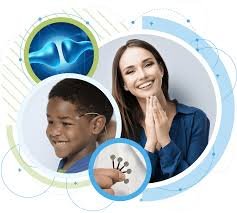Utilizing Microcurrent Neurofeedback for Children with ADHD
What is ADHD?
The brain is a complex and layered organ that operates much like a computer, but a computer that is individualized, has free will, and is deeply affected by outside forces. Because of this, no two brains are “wired” the same. This is what makes the human brain so unique and fascinating.
Our thought patterns are driven by brain waves, which also help regulate the rest of the systems in our bodies. When those brain waves become “stuck” or interrupted, the body responds in kind. ADHD, or Attention-Deficit/Hyperactivity Disorder, can be described a a dopamine dysregulation disorder. Dopamine is the chemical component that plays an important role in attention, mood, productivity, and emotional regulation. Children with ADHD often have too little dopamine, resulting in interruptions to key dopamine receptors. This makes it harder to focus, engage, and remain emotionally regulated.
Additionally, as seen through EEG’s, children with ADHD are often found to have dysregulated brain wave activity. Studies show that many children with ADHD have too much theta wave activity and not enough beta waves.
Theta waves are slower and most responsible for daydreaming and creativity. They also show up in a relaxed state, generally during light sleep or in the periods of time right before falling asleep. In addition, theta waves are responsible for emotional regulation—these are the waves that allow the human brain to process and understanding the emotions they’re feeling.
In children with ADHD, excessive theta waves, particularly in the frontal cortex, contribute to a feeling of mental fog and drowsiness. This is what lends to the sense that children with ADHD are in their “own worlds”, often lost in thought or unable to focus for a long period of time. Theta waves are crucial for creativity and memory, but when they’re dominant at the wrong time, they make it harder for children to pay attention and focus.
In contrast, beta waves are the fast-moving brain wave patterns that lend to a sense of “getting things done”. These brain waves are more active when we are alert, mentally engaged, focused, or solving problems. Beta waves also allow for emotional regulation as they help manage impulses and emotional responses.
An imbalance in any of the brain wave patterns can lead to dysregulation. In the case of ADHD, slower theta brain waves and higher beta waves can contribute to a lack of focus and impulse control.
What is Microcurrent Neurofeedback Therapy?
In simplest terms, MCN is a technology that utilizes low level electrical currents to stimulate and redirect neural pathways. This is an emerging treatment that is shown to help the brain “reboot” itself. MCN is increasingly used to treat mind-related issues such as depression, anxiety, ADHD and PTSD and many other disorders (see the full list below). It’s entirely safe, painless, non-invasive, and effective for both adults and children. In a typical MCN session, small electrodes are applied to a patient’s head to reflect brain waves and encourage a ‘re-routing’ of established brain wave patterns. This enables the brain to adjust itself by creating new brain wave patterns. Typical responses within the first few treatment are mental clarity, a sense of calmness, clearer senses, and more restorative sleep. Over 85% of patients observe a noticeable positive change in three to five sessions.
How Does MCN Help Children with ADHD?
Microcurrent Neurofeedback is a tool in the tool chest for parents and children battling the effects of ADHD. MRI studies show that children suffering from ADHD often have slight delays in brain development. While brain maturation may be delayed by up to 2-3 years, there are other contributing factors that complicate the ADHD brain. Addressing stuck brain patterns can help address a piece of the puzzle giving parents and children one more way to help establish healthy brain function.
Like all things, balance is key and MCN allows for a more balanced approach to helping the brain regulate not only emotions but also focus and concentration. Children with ADHD are not “lazy” or “undisciplined”. More often than not they are simply dysregulated. MCN uses low level electrical currents to disrupt the brain’s patterns. Microcurrent neurofeedback offers hope and calm in a gentle, non-invasive way. For some children with ADHD, it helps their nervous system settle so they can better focus, regulate, and thrive. It’s especially appealing for families looking for a holistic, brain-based approach without relying solely on meds.
Is MCN Right for My Child?
Many parents seek microcurrent neurofeedback as an alternative or complementary treatment for neurological and behavioral challenges, as it has been reported to improve focus, emotional regulation, sleep, and overall cognitive function. These reports are mostly anecdotal, but more studies are being done to support the claims. Because the therapy works by encouraging the brain to reset rather than forcing it to change, side effects are typically minimal. Some children may experience temporary fatigue, mild headaches, or increased emotional sensitivity after a session, but these effects usually resolve quickly.
That said, every child is different, and it’s always best to consult with a qualified healthcare provider before starting any new treatment. A trained practitioner can assess whether microcurrent neurofeedback is appropriate based on a child’s specific needs and medical history. At Christian Counseling of Tampa, we have trained professionals who can determine if MCN would be a good course of treatment for your child. Call us today to set up an initial assessment.



